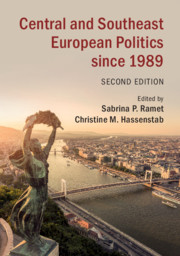Book contents
- Central and Southeast European Politics since 1989
- Central and Southeast European Politics since 1989
- Copyright page
- Dedication
- Contents
- Figures and Maps
- Tables
- Contributors
- Preface
- Glossary
- Guide to the Pronunciation of Central and Southeast European Words
- Additional material
- Part One Introduction
- Part Two Issues
- Part Three Central Europe
- 6 Poland since 1989: Muddling through, Wall to Wall
- 7 Building Democratic Values in the Czech Republic since 1989
- 8 Slovakia since 1989
- 9 Two Faces of Hungary
- Part Four Yugoslav Successor States
- Part Five Southeastern Europe
- Part Six Present and Future Challenges
- Index
- References
8 - Slovakia since 1989
from Part Three - Central Europe
Published online by Cambridge University Press: 16 September 2019
- Central and Southeast European Politics since 1989
- Central and Southeast European Politics since 1989
- Copyright page
- Dedication
- Contents
- Figures and Maps
- Tables
- Contributors
- Preface
- Glossary
- Guide to the Pronunciation of Central and Southeast European Words
- Additional material
- Part One Introduction
- Part Two Issues
- Part Three Central Europe
- 6 Poland since 1989: Muddling through, Wall to Wall
- 7 Building Democratic Values in the Czech Republic since 1989
- 8 Slovakia since 1989
- 9 Two Faces of Hungary
- Part Four Yugoslav Successor States
- Part Five Southeastern Europe
- Part Six Present and Future Challenges
- Index
- References
Summary
The chapter traces political developments in Slovakia from its sudden and controversial emergence as an independent state, following the breakup of Czechoslovakia, to the present day. Slovakia’s slow and difficult transition to democracy in the 1990s has been marked by nationalism and ambivalent attitude to liberal democracy and relations with the West. This was followed by a period of successful “Europeanization” and accession to the European Union and a relatively quick and successful joining of the Eurozone. It is argued that, despite the near-permanent political turbulence and the fluctuating party system, Slovakia’s democracy is progressing well, if not without problems. In highlighting problematic issues, it is suggested that they derive mostly from the absence of statehood tradition, the speed of reforms, and the legacy of communism. The misinterpretation of independence as the “ownership” of the state increases nationalist leanings within society, which then tolerates hostility to other ethnicities and immigrants. This negative legacy, when combined with post-communist distortion of history, the economic and social insecurity associated with speedy transition, and the absence of political responsibility, perpetuates corruption. The conclusion, whilst detailing these processes, argues that the democratization process in Slovakia has been perhaps more successful than expected, even if by no means complete.
Keywords
- Type
- Chapter
- Information
- Central and Southeast European Politics since 1989 , pp. 191 - 220Publisher: Cambridge University PressPrint publication year: 2019
References
Further Reading
- 2
- Cited by



